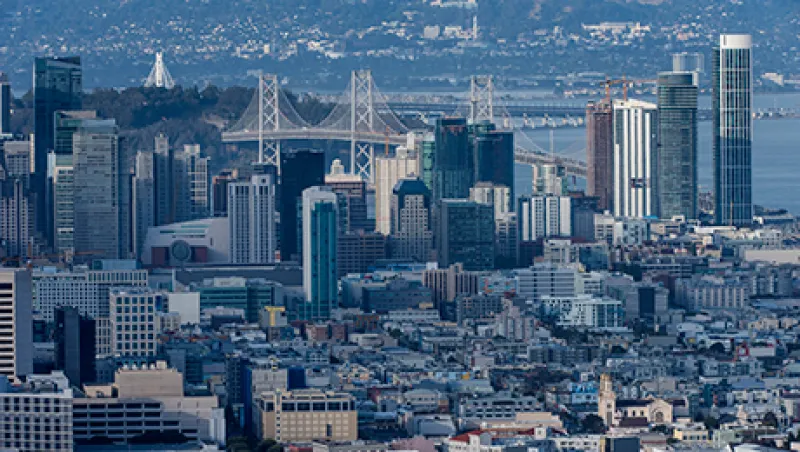With capitalization rates near record lows, prices for buildings soaring and rents rising as vacancy rates shrink, talk is spreading that commercial real estate may be in bubble territory. But whereas analysts see signs of frothiness in a few pockets of the market, they say that the situation overall really isn’t overdone.
“We may ultimately end up in a bubble, but we aren’t out over our skis yet,” says Ryan Severino, senior economist at New York real estate research firm Reis.
The market’s strength isn’t excessive, because fundamentals justify valuations, as evidenced by climbing rents and falling vacancy rates, analysts say. Investor demand is strong, with foreigners and pension funds in particular making their presence felt. And although lending standards are loosening, they aren’t anything close to their abysmal state of 2006–’07.
Among the strongest sectors are commercial business district offices, for which the Real Capital Analytics property price index has jumped 40 percent above its 2007 peak, and the apartment sector, for which RCA’s index has advanced 32 percent above its 2007 zenith.
In the office sector, gains are typically coming from high-price, core assets in prime locations, says Jim Costello, senior vice president of New York–based RCA, a real estate research firm. Suburban office properties remain 10 percent below their 2007 peak, he notes.
The story in office real estate is technology, Severino says. “It’s a very concentrated recovery. Tech-oriented cities have done well.” They include San Francisco, San Jose and Oakland, California; Austin, Texas; Denver; New York City; and Seattle. “There isn’t a lot of strength in markets that are outside technology,” Severino says.
With a finite number of investment opportunities in the biggest cities, capital is flowing to the smaller ones, and those markets are in danger of overheating, says Sam Chandan, founder and chief economist at Chandan Economics, a real estate research firm in New York. He declined to name specific cities.
A number of factors explain the apartment market’s strength. After the Great Recession, more people began renting, as incomes fell and mortgage requirements tightened. Today, young people in particular are opting to rent amid difficulty finding high-paying jobs. As a result, “apartments are the darling of commercial real estate,” Severino says. “That’s where investors are most enthusiastic.”
As for commercial real estate’s market fundamentals, occupancy rates have risen to 92 percent from a 2009 low of 89 percent, according to Newport Beach, California–based real estate research firm Green Street Advisors. And rent is rising at a 4 percent annual pace, after annual increases of 3 percent in 2012–’14. “Low cap rates and high valuations are justified in most instances,” Severino says.
On the investment front, there is plenty of demand to keep property prices afloat, analysts say. Capital is flooding in from overseas. Foreign investment now accounts for about 12 percent of direct property purchases, up from 8 percent in 2000, according to RCA. Whereas cap rates are at historic lows — 5.1 percent for office properties, according to Green Street — they remain above those elsewhere in the world, making the U.S. market attractive, Costello says. In February Anbang Insurance Group of China bought New York’s Waldorf Astoria for $1.95 billion, a record for a U.S. hotel.
Meanwhile, U.S. pension funds now devote 7.7 percent of their assets to real estate, up from 6.3 percent in 2011, according to research firm Preqin. “Pension funds have large obligations, and they can get close to 8 percent returns in real estate,” Costello says. “They aren’t going to get that anywhere else.”
On the debt side, banks and other lenders are loosening underwriting standards. “But we’re nowhere near 2007 levels when it comes to the availability of debt capital,” says Andy McCulloch, managing director of real estate analytics at Green Street. The loan-to-value ratio for commercial real estate was 66 percent in the third quarter, down from 71 percent in 2007, according to RCA. “The ‘V’ in that equation is more realistic today,” McCulloch says.
That’s a powerful argument against a bubble, Severino says. “Bubbles tend to be debt-fueled, and we aren’t seeing it like 2006–’07.”
When it comes to interest rates, hikes by the Federal Reserve are unlikely to upend the market, most analysts say. “The Fed only controls the short end of the yield curve, and real estate is priced off the long end,” McCulloch says. “It might not have any impact.”
But Chandan isn’t so sanguine. “As monetary policy tightens and investors demand higher yields, there are sectors of real estate where asset prices will correct.” Still, even he says it’s just “pockets of the market that are inflated.”
So the good times may well continue. “It’s not that things can’t go wrong, but I don’t think anything stupid is happening,” Costello says.







